Projects/Fairs
ARCOmadrid – “Nunca lo mismo. Arte latinoamericano” Section – Booth NLM01 | Madrid, España
_VIGILGONZALES is pleased to announce its participation in ARCOmadrid, where it will present pieces by Violeta Quispe Yupari (Lima, 1989) in Nunca lo mismo Section, curated by Manuela Moscoso and Jose Esparza. The presentation, entitled "Huchamanta kacharisqa kaq / La que está libre de pecado" (The she who is free of sin), is accompanied by a curatorial text by peruvian Doctor of History and Art Critic Gabriela Germaná.
_VIGILGONZALES proposes to put into circulation the "dialects" of Latin American contemporary art, marked by the regions where the various artists on its roster work. In this sense, Quispe Yupari is positioned as an indispensable representative of the traditional Andean art of the Sarhua region. During the current year, we will also accompany Quispe Yupari in her participation in La Biennale di Venezia under the theme "Foreigners Everywhere" and the curatorship of Adriano Pedrosa.
Huchamanta kacharisqa kaq / La que está libre de pecado / The she who is free of sin,
by Dr. Gabriela Germaná (Ph.D)
The body is an important site of enunciation for many women artists. Since the late 1960s, due in large part to the development of feminist movements, many artists have sought to express their own experiences and perspectives, and have questioned how women have been defined from a patriarchal perspective and under reductive and canonical notions of female identity. Self-portraiture, especially, has given them the possibility of representing their own bodies and counteracting the conventional meanings that have been assigned to them, claiming a space for self-expression from their own experiences and interests. The work of Violeta Quispe Yupari (Lima, 1989) has focused on demanding women's equality and denouncing gender violence, especially against Andean women, as well as on the vindication of the indigenous from a critical stance that questions the patriarchy rooted in the Andean context. Although Violeta's work generally maintains a self-referential tone, on this occasion she decides to directly review her own history to question the role assigned to women, to refer to the violence of patriarchy, and to look for ways to heal in the face of it.
Violeta is the daughter of Gaudencia Yupari and Juan Walberto Quispe, two renowned artists from the rural community of Sarhua, located in the department of Ayacucho, in the peruvian Andes. Violeta learned to paint with her parents in the style and technique of the Sarhua Tables, paintings on wood that have been produced in this community, with various transformations, since at least the 19th century. Although Violeta comes from this painting tradition, in recent years she has been developing a very personal style. Inspired first by the work of other contemporary peruvian artists, Violeta decided, through her paintings, to make women visible and listen to their own voice. She needed to express that "we are here, we are present". She has also been researching and experimenting with a series of new materials and resources that allow her to better express her concerns. Thanks to this production, her work has been recognized nationally and internationally.
The five main works that are part of this exhibition have been made by Violeta in recent months, one of them in conjunction with her mother Gaudencia Yupari. Using in many cases references to phrases from the Catholic Church (an institution that reinforces patriarchy in the Andean area), she transforms them to reflect, from her perspective as an Andean woman, daughter of a migrant woman in the city of Lima, on issues such as motherhood, marriage, the roles assigned to women and even the political role of women.
Mamapa sutinpi, churiy mana churiyuq. Amen (In the name of the mother and the childless daughter. Amen, 2024), a large sculpture in maguey trunk and painted with the artist's menstrual blood, is about maternity. The work begins at the bottom with a first scene in homage to the more than 20,000 women forcibly sterilized by the peruvian government between 1995 and 2000. Then, through her mother's and her own experiences, she questions how motherhood has been imposed on women. Both her mother and Violeta grew up in environments where motherhood was considered natural for all women. While her mother, a fertile woman, was able to have children, among them Violeta, faced with unwanted pregnancies, had to undergo clandestine abortions. Violeta, on the other hand, an infertile woman, had to deal with the idea of being an incomplete woman and underwent exhausting treatments that did not work. Finally, Violeta manages to reconcile with her own body, breaking a cycle of patriarchal violence.
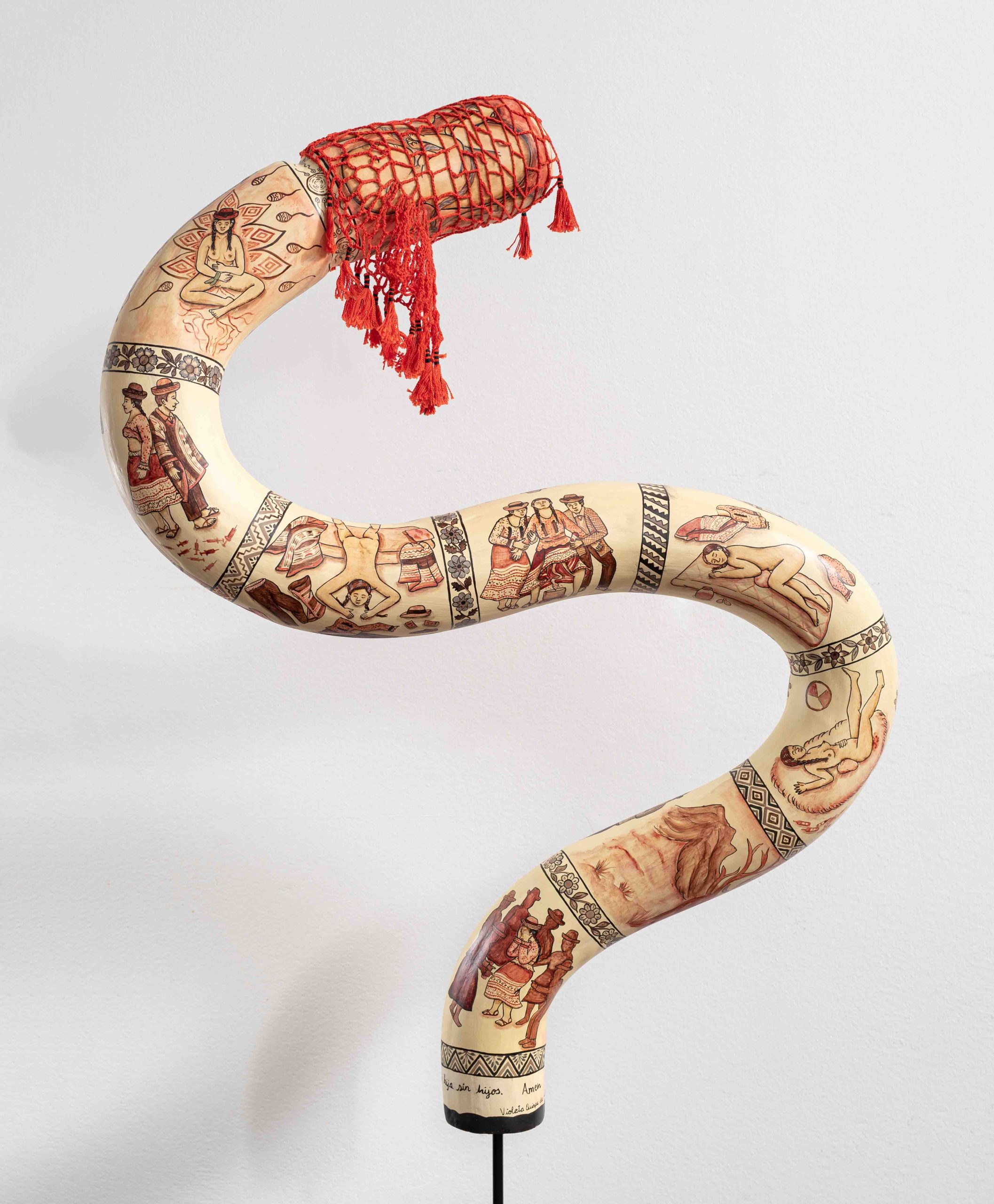
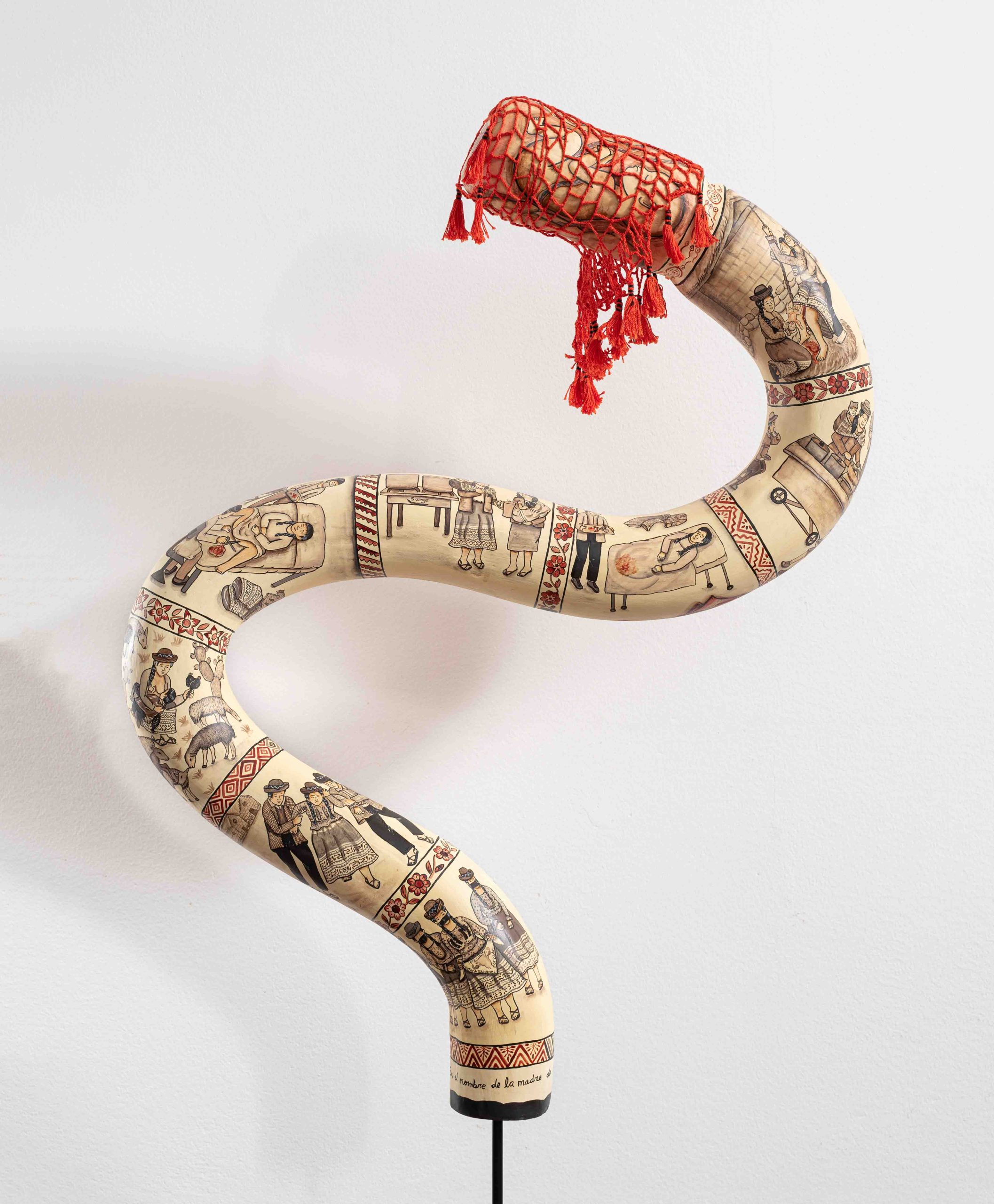
Warmi: kaypi churiy, churiy kaypi mamay (Woman, behold your daughter, daughter behold your mother, 2024), done by Violeta and her mother Gaudencia Yupari (you can compare the two painting styles on the same board), narrates from bottom to top, first her mother's life in the community of Sarhua and how she had to leave the community in the 1980s due to the internal armed conflict to relocate to Lima. The upper part of the Table, painted by Violeta, shows her childhood memories in the Delicias de Villa slum in Lima, accompanying her mother to fetch water from the well or washing clothes in the river, listening to her father play the guitar, or attending craft fairs with her mother. There are two scenes that show the complicity of mother and daughter, who nowadays often go to protest marches and participate in exhibitions together. In one of them, in the center of the Table, Violeta and Gaudencia participate in a protest for women's rights; in the other, at the top, both are at the current edition of ARCOmadrid. Alongside this work is a "traditional table" made by Gaudencia Yupari in 1992 in which he depicts, in his characteristic style, the way of life in Sarhua. Although it is an idyllic vision in which the cooperation between men and women (or the traditional family) works perfectly, there is an emphasis on the work done by women that shows the importance that they have had, although it has not been very well recognized, in the Sarhua society.
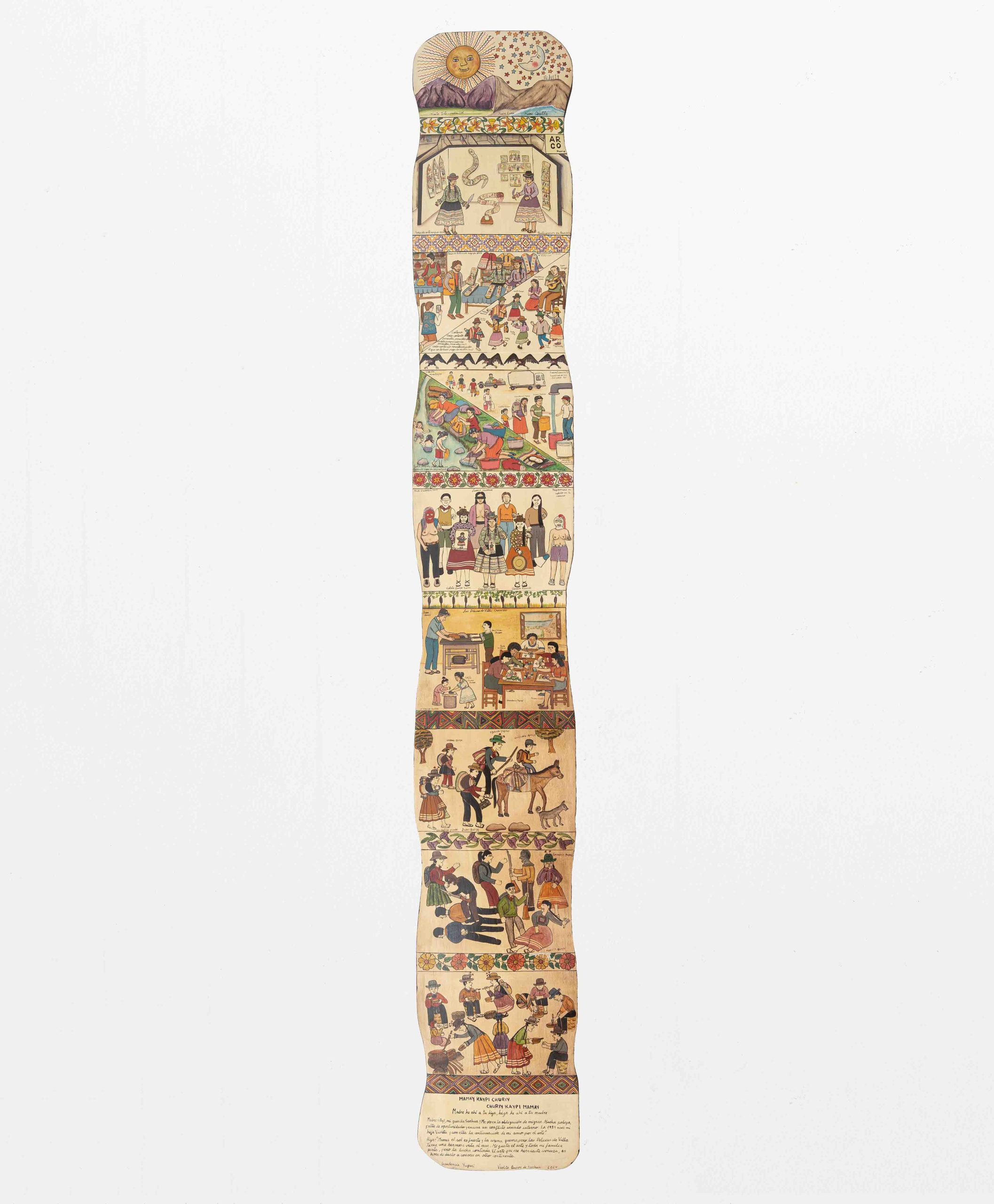
The polyptych El matrimonio de las cholas (The cholas' marriage, 2024) also questions the roles imposed on women, specifically the idea of marriage as a fundamental achievement. In the work, Violeta again contrasts her mother's experiences with her own. In the central panel, while on the left side is the marriage of her parents, in Sarhua, under the approval of the Catholic Church, on the right side is Violeta's self-portrait, alone, in the slums of Lima, protected by an image of Lilith, whom Violeta unites with Pachamama or Mother Earth (two powerful female deities from non-Western contexts and denied by the Catholic Church). In the lower area, Violeta shows her mother and grandmothers who, although strong, had to live under the mandates of a patriarchal society. Her mother is depicted giving birth in a vertical birth, as is traditional in many Andean communities, and connects her, by means of a rope, to Violeta in the upper section of the work. But this connection is broken. Influenced by women with different backgrounds (from her Sarhuina teacher to activist friends in Lima and feminist artists from various parts of the world), Violeta frees herself from following the fate of her predecessors.
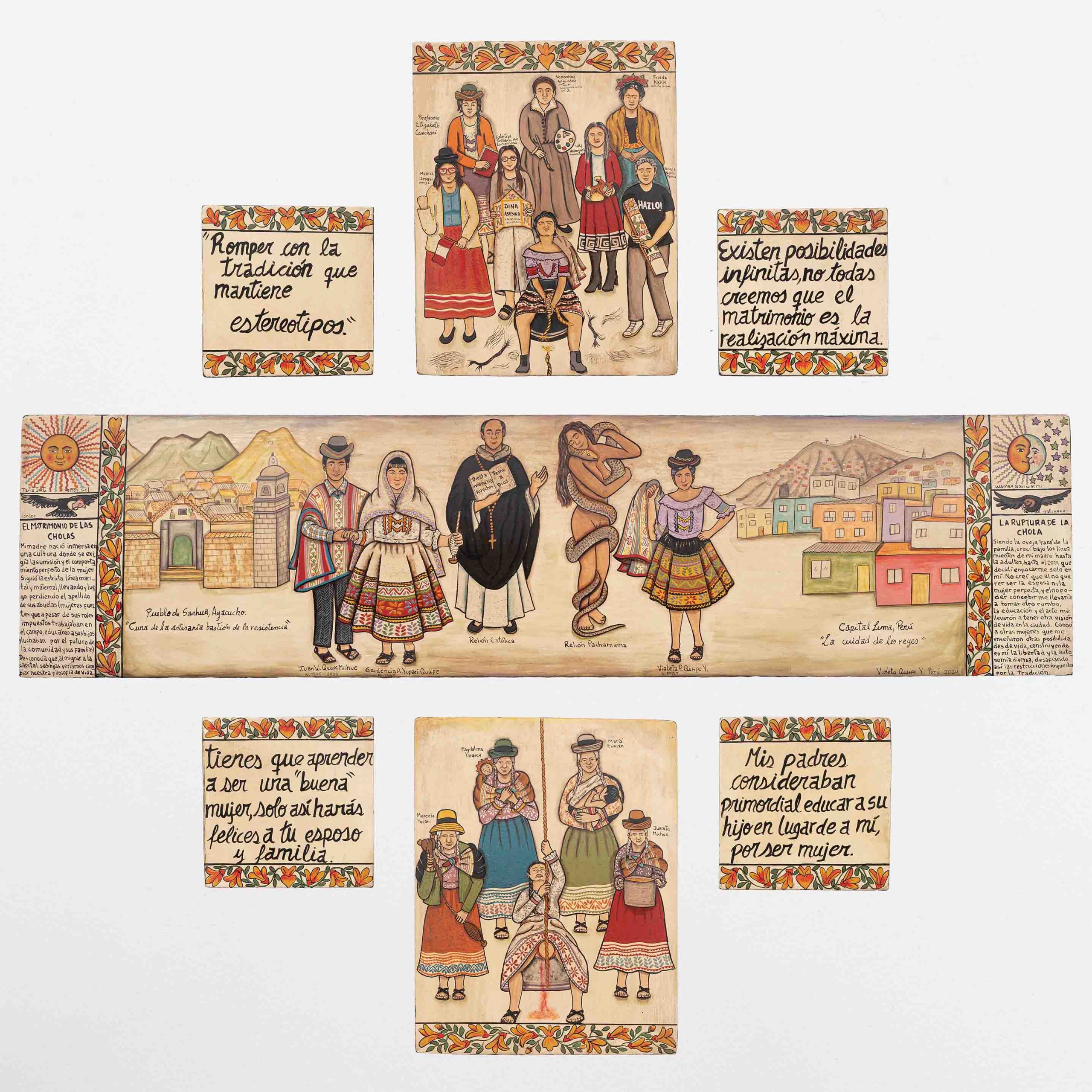
Sinless conceived (2004), also questions the roles imposed on women. It begins at the bottom with the biblical scene of "universal sin" in which Eve is blamed for the expulsion of human beings from Paradise. It then refers to all those activities that Violeta was told that as a woman she could not do and how the bad things that happened to her were supposedly related to her bad actions. An image located in the center of the sequence shows Violeta between an angel and a devil, figures used by the Catholic Church to symbolize good and evil. Finally, in the upper area of the Table, Violeta shows how she has decided to live her life fully and considering what is best for her, regardless of the conventions imposed on women, including one of her last actions which was to cut her hair short, which, in Sarhua, as in other conservative societies, is usually considered inappropriate for a woman.
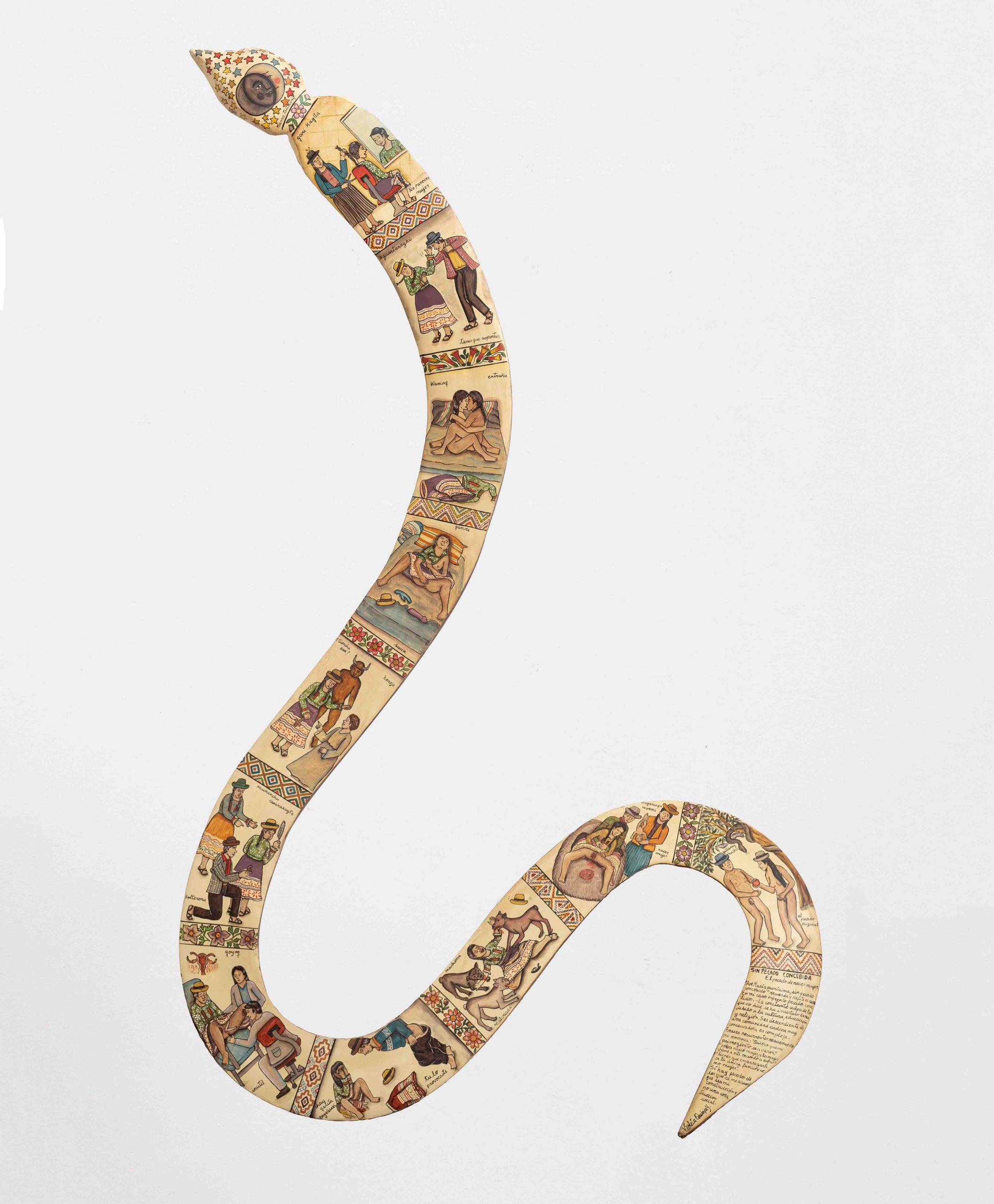
Saminchasqa: Mamawan, churiy chanin política nisqapaq maqanakunku (Blessed: Mother and daughter fighting for just politics, 2024) is a triptych on dried cabuya leaves. It refers to the political problems in both Sarhua and Lima (which, being the capital, have national repercussions) in relation to gender issues and how Violeta and her mother's struggle includes the demand for a more just society for all. In the painting on the left, Violeta refers to Sarhua, a community governed by official authorities, but in which the traditional authorities - a system composed only of men - are of greater importance. However, when the Sarhuinos and Sarhuinas must vote for the official authorities, they are either uninformed or manipulated by the promises of unscrupulous politicians. In the painting on the right, Violeta paints the last five presidents of Peru, all men as well, as well as the difficulty of finding good politicians and the manipulations exercised by them with the population. Both paintings end with scenes that reflect on the need for education in order to be able to exercise an informed political commitment. The central painting refers to the most recent events in peruvian politics and how years of mismanagement have led to a scenario in which, under the command of the first female president, the army abused, injured and killed more than 60 peruvians, including many Andean women, for protesting for their rights and a fairer country for marginalized communities. These images, depicted upside down, contrast with the image at the bottom of the panel showing Violeta and her mother participating in protest marches against government policies.
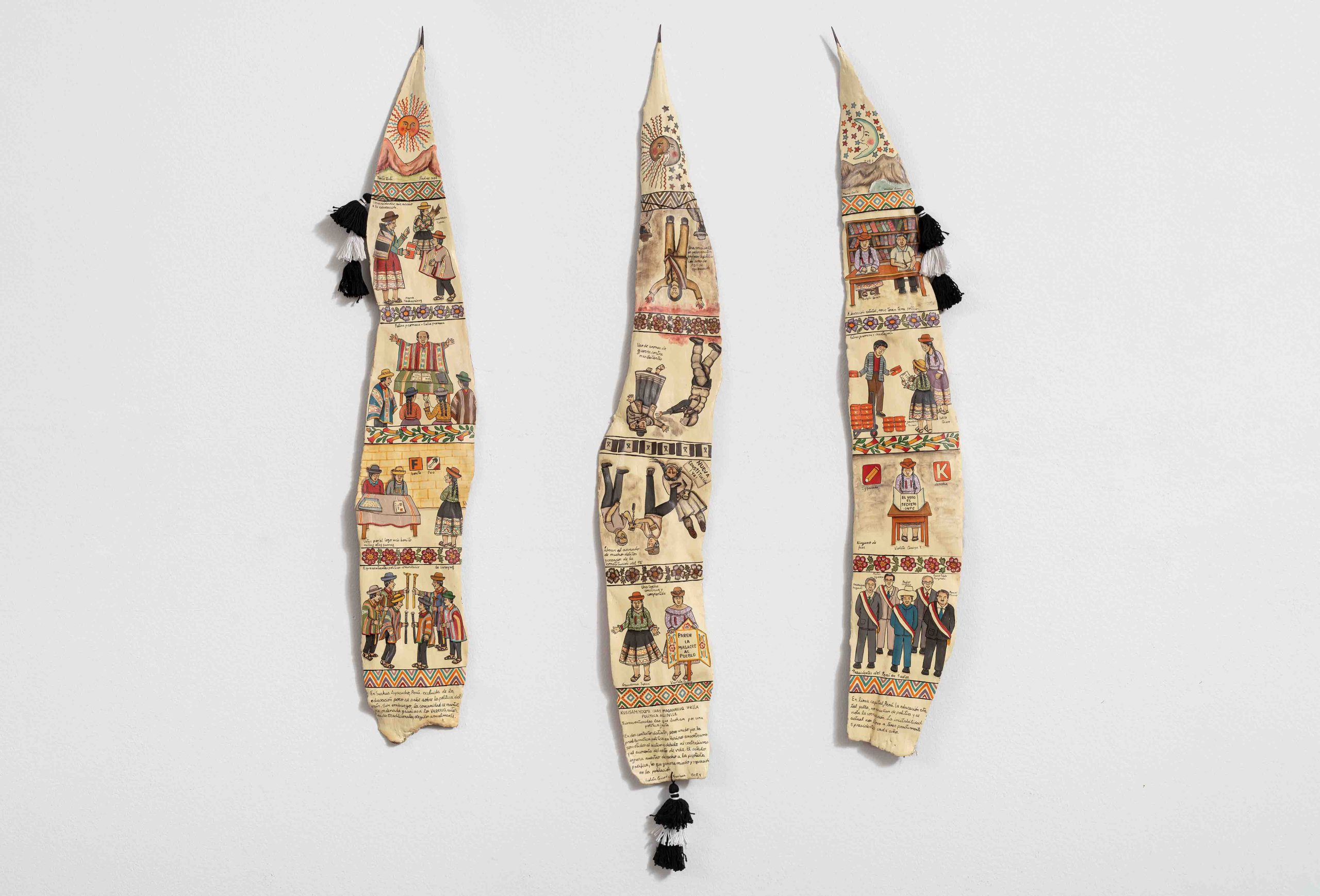
Along with this work are included a set of works made in previous years by Violeta: Warmi Quejakuy I (Woman's Complaint I, 2019), Chejnecuq quk color Karin (Hate for the color of the skin, 2019) and 25 N (2021). Also through self-portraiture, they refer to the violence and discrimination and racial discrimination suffered by Sarhuina women and, in general, Andean women, and the need to protest against these facts.
Violeta Quispe departs from the techniques and figurative style of the Sarhua Tables to produce works that, in a style very much her own, reflect on the harsh experiences of her own history and linked to it, those of her mother, two Andean women in different circumstances. Gaudencia Yupari, born and raised in Sarhua and a migrant in Lima since the 1980s, and Violeta Quispe Yupari, born in the outskirts of Lima, daughter of Sarhuino migrants. From her own story, Violeta questions patriarchy and protests vigorously against discrimination and gender violence. From a decolonial feminism, Violeta responds to the hegemonic discourse, not only in terms of class and race, but also in terms of gender. Finally, it should be noted how Violeta is challenging the patriarchal social order from the place of an Andean woman, born in Lima, and from there she is contributing to reshape contemporary peruvian art.
Artist:
Violeta Quispe Yupari